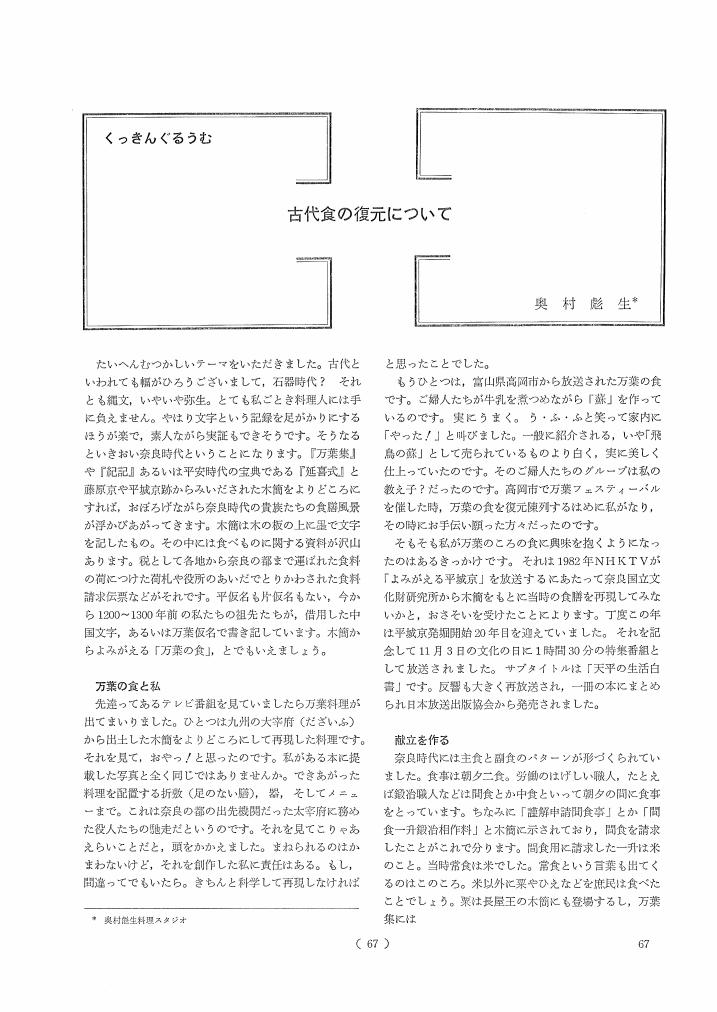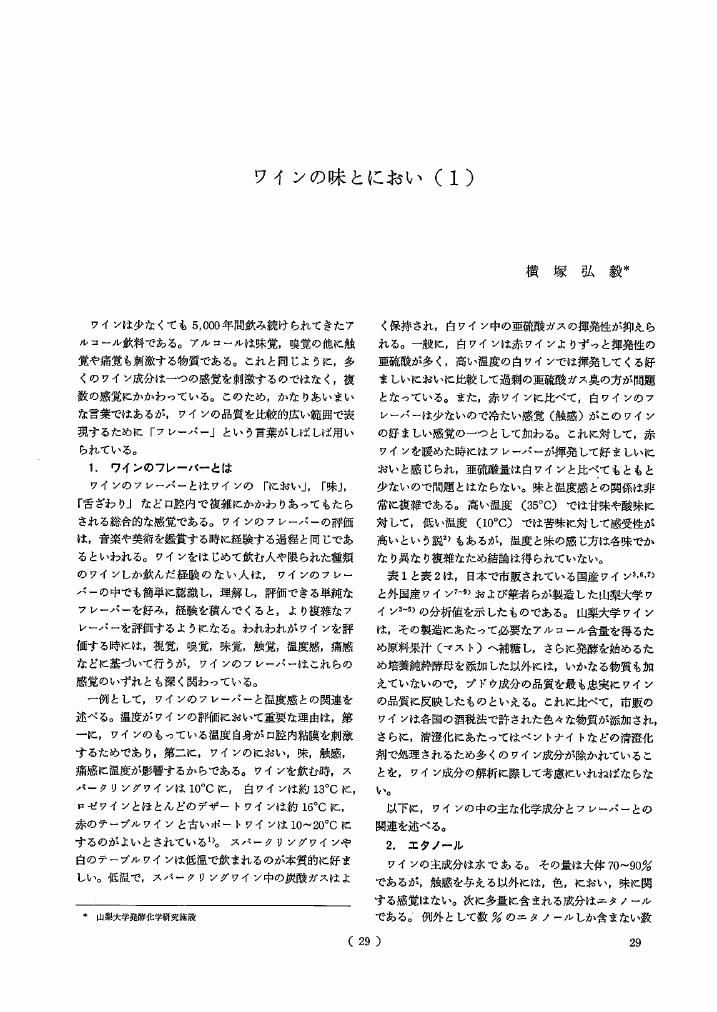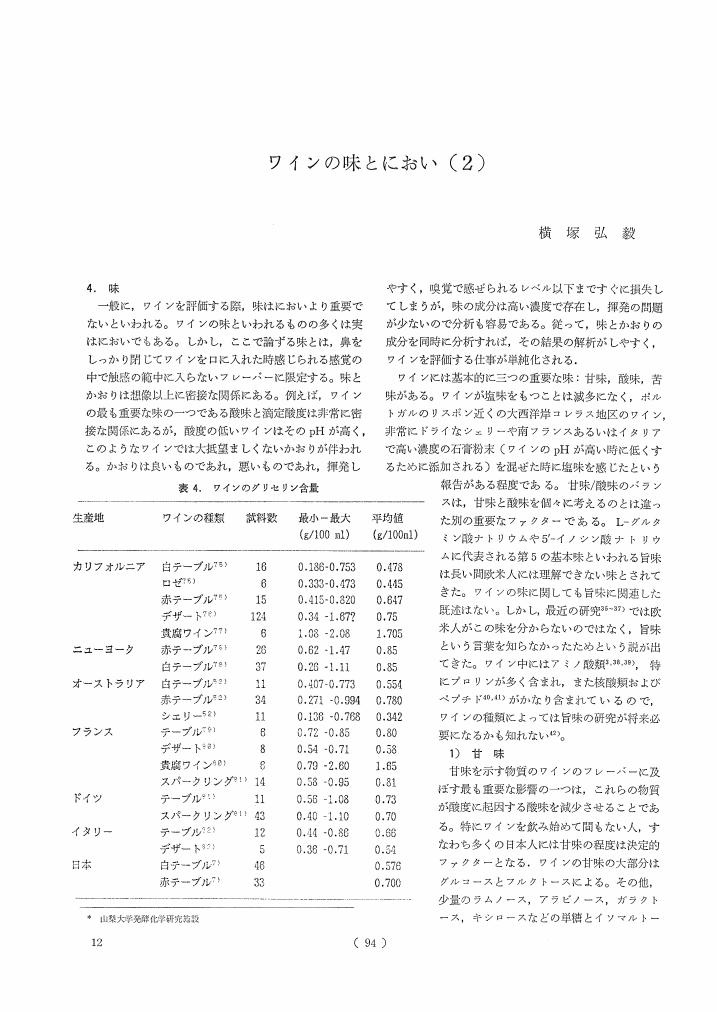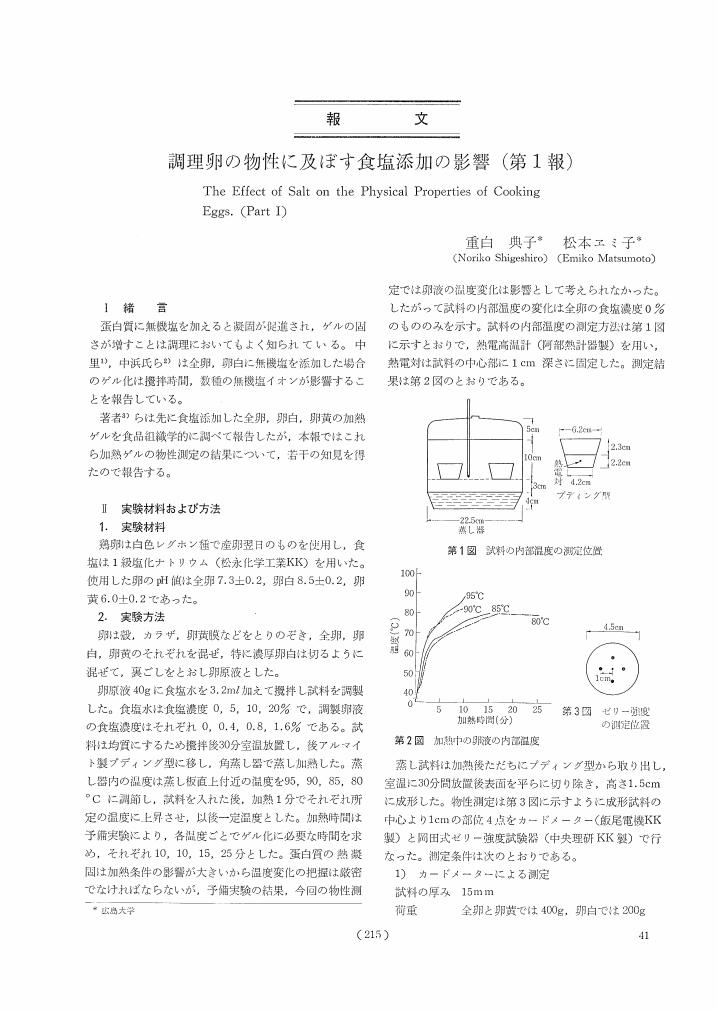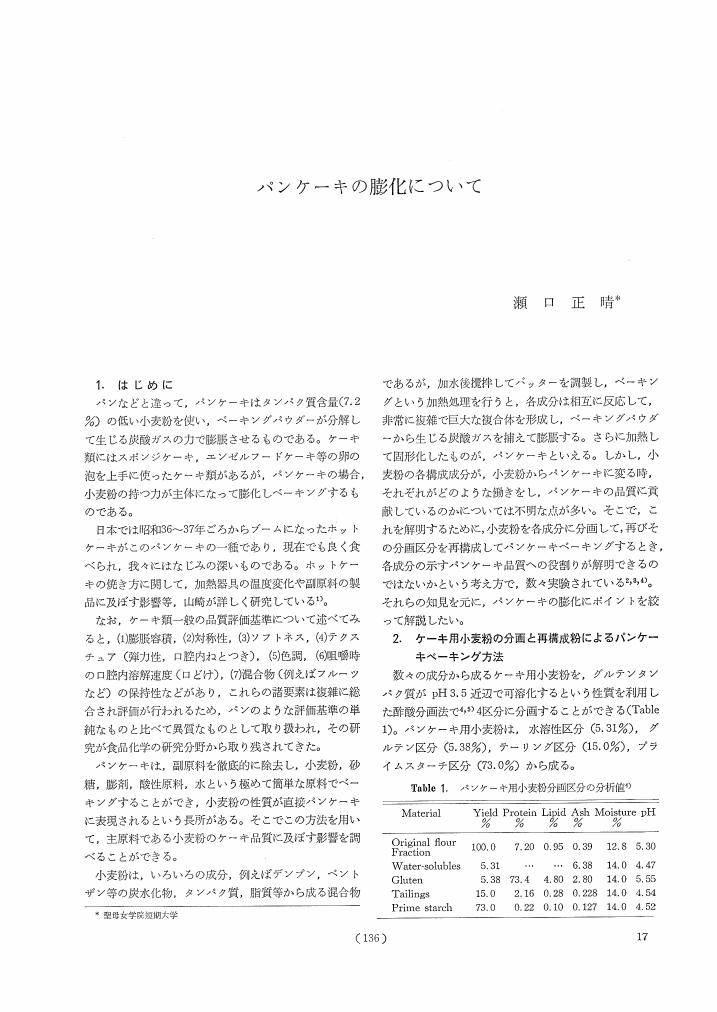1 0 0 0 OA 果糖の調理への応用
- 著者
- 松下 慎哉
- 出版者
- 一般社団法人 日本調理科学会
- 雑誌
- 調理科学 (ISSN:09105360)
- 巻号頁・発行日
- vol.7, no.1, pp.7-11, 1974-02-20 (Released:2013-04-26)
- 参考文献数
- 21
- 被引用文献数
- 1
1 0 0 0 OA ゆば膜の生成と利用
- 著者
- 岡本 奨
- 出版者
- 一般社団法人 日本調理科学会
- 雑誌
- 調理科学 (ISSN:09105360)
- 巻号頁・発行日
- vol.9, no.3, pp.135-141, 1976-09-20 (Released:2013-04-26)
- 参考文献数
- 17
1 0 0 0 冷凍食品の調理科学的研究(第1報):フライ食品について
- 著者
- 岩村 泰子 元山 正
- 出版者
- 一般社団法人 日本調理科学会
- 雑誌
- 調理科学 (ISSN:09105360)
- 巻号頁・発行日
- vol.12, no.2, pp.112-116, 1979
調理冷凍食品のうち,魚のフライ,コロッケについて冷凍時の生菌数,大腸菌群数を調べ,これを揚げた場合の内部温度と細菌数の残存について検討した. その結果 1)冷凍フライ中の生菌数は平均104~105/9の汚染度を示し,大腸菌群数は102~103M.P.N/9であった. 2)コロッケは俵型,小判型ともに汚染度が高く, 生菌数105/g,大腸菌群数は俵型コロッケ103M.P.N/g,小判型コロッケ105M.P.N/9であった. 3)内部温度を測定しながら揚げた魚のフライでは170℃ 5分で, 内部温度は80℃となったが, 生菌数は残存がみられるものがあった. 大腸菌群数は検出されたものはなかった. エビフライ, カキフライは160℃で4分揚げたものが好ましかった. 4)コロッケは俵型と小判型を揚げたが,俵型は熱伝導が悪く, 揚げるのに時間を要する. 本実験から175℃5分が適当と思われた. 小判型は内部温度の上昇が早く175℃ 4分で内部温度は90℃に達した. 5)コロッケを揚げた場合の細菌数の残存は俵型では175℃ 5分揚げたものには少なかった. 小判型は内部温度が高くなったにもかかわらず細菌数の残存が多くみられた.
1 0 0 0 OA 古代食の復元についで
- 著者
- 奥村 彪生
- 出版者
- 一般社団法人 日本調理科学会
- 雑誌
- 調理科学 (ISSN:09105360)
- 巻号頁・発行日
- vol.24, no.1, pp.67-70, 1991-02-20 (Released:2013-04-26)
1 0 0 0 OA 女子大学生の食生活の実態と嗜好について
- 著者
- 斉藤 智子 川名 光子
- 出版者
- 一般社団法人日本調理科学会
- 雑誌
- 調理科学 (ISSN:09105360)
- 巻号頁・発行日
- vol.10, no.4, pp.258-264, 1977-12-20
変遷途上にある我が国の食生活の位置と動向について知ることを目的として,現代の女子大学生の食生活の実態を調査し,食生活に対する意識調査・並びに食品とその料理における嗜好の調査を行って次のような結果が得られた。1)食事の摂取状況について:朝食においては夏期スクーリング受講生が通学課程の女子大学生より良好な摂取状況である。昼食・夕食においては全体的に極めて良い摂取状況である。間食においては通学課程の女子大学生が夏期スクーリング受講生より頻度高く摂取している。2)主食について:朝食においては夏期スクーリング受講生の米飯食者が通学課程の女子大学生より多い。朝食にパンを食する者も昼食・夕食には米飯食をする者が多くなっている。要するに米を土台として米飯食とパン食の混食が行われている。3)朝食について:パン食には甘味のものが好まれ,米飯食には塩味のものが好まれるという従来からの代表的な組合せが減少して,ジャム・佃煮類に代って栄養価の高い牛乳・野菜・果物・卵などの摂取が多くなっている。4)摂食意識について:Sグループにみられるように年齢が高い方が食生活に対して積極的意識が認められる。5)食品と料理の嗜好について:食品の嗜好とその料理の嗜好関係については有意差の検定を行い,それを第1図のような表現を用いて一目で解るものとしたが,このような方法を用いることによって食品と料理の嗜好の関係を明らかにすることが出来ると思われる。一般に各料理食品について,調理法が洋風化している料理の方が好まれる傾向にある。調査結果から女子大学生の給食献立として好まれる料理は,魚の塩焼き・魚の照焼き・ハンバーグ・豚生姜焼き・ぎょうざ・とりのから揚げ・野菜サラダ・グラタン・クリームシチューなどがあげられる。また好まれない料理としては,魚の酢の物・煮魚・魚の干物・しめ鯖・かきフライ・ソーセージ・麻婆豆腐・いり豆腐・生揚油揚の煮物・和風野菜料理・煮昆布・ひじきの煮つけなどがあげられる。本調査において現代の女子大学生の食生活の実態を把握し,その嗜好傾向に基づいて豊かな食生活実現の方向づげとし,あわせて今後の食生活の動向を知る資料としたい。おわりに本研究にあたり御懇篤な御指導を賜りました日本女子大学,武藤静子先生,中浜信子先生に厚く御礼申し上げます。なお統計的計算には日本女子大学計算研究所のTOSBAC3400を使用し,御指導,御協力をいただいた同研究所二宮玲子先生に感謝申し上げます。
1 0 0 0 OA 熱のつたわり方( I I )
- 著者
- 吉田 敏臣
- 出版者
- 一般社団法人 日本調理科学会
- 雑誌
- 調理科学 (ISSN:09105360)
- 巻号頁・発行日
- vol.12, no.1, pp.32-36, 1979-04-01 (Released:2013-04-26)
- 参考文献数
- 1
- 被引用文献数
- 2
1 0 0 0 ワインの味とにおい(1)
- 著者
- 横塚 弘毅
- 出版者
- 一般社団法人 日本調理科学会
- 雑誌
- 調理科学 (ISSN:09105360)
- 巻号頁・発行日
- vol.22, no.1, pp.29-36, 1989
1 0 0 0 ワインの味とにおい(2)
- 著者
- 横塚 弘毅
- 出版者
- 一般社団法人 日本調理科学会
- 雑誌
- 調理科学 (ISSN:09105360)
- 巻号頁・発行日
- vol.22, no.2, pp.94-101, 1989
1 0 0 0 OA 照葉樹林帯の食物文化
- 著者
- 佐々木 高明
- 出版者
- 一般社団法人 日本調理科学会
- 雑誌
- 調理科学 (ISSN:09105360)
- 巻号頁・発行日
- vol.27, no.3, pp.197-203, 1994-08-20 (Released:2013-04-26)
1 0 0 0 OA ゼラチンゼリーを作る
- 著者
- 河村 フジ子
- 出版者
- 一般社団法人 日本調理科学会
- 雑誌
- 調理科学 (ISSN:09105360)
- 巻号頁・発行日
- vol.23, no.2, pp.156-159, 1990-05-20 (Released:2013-04-26)
- 参考文献数
- 10
1 0 0 0 OA ワインの味とにおい(1)
- 著者
- 横塚 弘毅
- 出版者
- 一般社団法人 日本調理科学会
- 雑誌
- 調理科学 (ISSN:09105360)
- 巻号頁・発行日
- vol.22, no.1, pp.29-36, 1989-03-20 (Released:2013-04-26)
- 参考文献数
- 34
1 0 0 0 OA ワインの味とにおい(2)
- 著者
- 横塚 弘毅
- 出版者
- 一般社団法人 日本調理科学会
- 雑誌
- 調理科学 (ISSN:09105360)
- 巻号頁・発行日
- vol.22, no.2, pp.94-101, 1989-06-20 (Released:2013-04-26)
- 参考文献数
- 57
- 被引用文献数
- 1
1 0 0 0 OA 食品の乾燥(2)
- 著者
- 林 弘通
- 出版者
- 一般社団法人 日本調理科学会
- 雑誌
- 調理科学 (ISSN:09105360)
- 巻号頁・発行日
- vol.25, no.1, pp.66-75, 1992-02-20 (Released:2013-04-26)
- 参考文献数
- 4
1 0 0 0 OA マカダミア・ナッツ(Macadamia ternifolia)のタンパク質について
- 著者
- 光永 俊郎 安達 潤子 蔵前 栄子 荒堀 圭子
- 出版者
- 一般社団法人 日本調理科学会
- 雑誌
- 調理科学 (ISSN:09105360)
- 巻号頁・発行日
- vol.15, no.4, pp.217-221, 1982-12-20 (Released:2013-04-26)
- 参考文献数
- 15
- 被引用文献数
- 1
1)マカダミアナッツの可溶性タンパク質を,水,食塩水,アルコール溶液,水酸化ナトリウム溶液を用いて分別抽出した.抽出率は97%であり,主画分は,アルブミンで,総タンパク質の約70%を占めていた.次いで,グルテリン,グロブリン,プロラミンの順であった.2)各タンパク質画分の電気泳動像は,それぞれ特徴のあるパターンを示し,各画分とも多種類のポリペプチドよりなり,プロラミン,グルテリン画分は,高分子ポリペプチドを多く含んでいた.3)各画分のアミノ酸組成は,グルタミン酸,アルギニンの高含量,含硫アミノ酸の低含量を特徴とし,アミノ酸価は,17.1から51.4であった.全タンパク質は51.4でごまのタンパク質とほぼ同じ値を示した.4)アルブミン画分は,ゲル濾過により,6画分にわけられた.さらにこれらの画分の電気泳動像は,それぞれ3~10種のパンドが認められ,極めて多種類の構成ポリペブチドよりなることを示した.
1 0 0 0 OA 調理卵の物性に及ぼす食塩添加の影響 (第1報)
- 著者
- 重白 典子 松本 ヱミ子
- 出版者
- 一般社団法人 日本調理科学会
- 雑誌
- 調理科学 (ISSN:09105360)
- 巻号頁・発行日
- vol.9, no.4, pp.215-218, 1976-12-20 (Released:2013-04-26)
- 参考文献数
- 10
- 被引用文献数
- 2
1 0 0 0 OA カレー粉加熱香気成分の同定と調理による変化
- 著者
- 河村 フジ子 加藤 和子 畑中 としみ
- 出版者
- 一般社団法人 日本調理科学会
- 雑誌
- 調理科学 (ISSN:09105360)
- 巻号頁・発行日
- vol.20, no.3, pp.240-245, 1987-11-20 (Released:2013-04-26)
- 参考文献数
- 14
- 被引用文献数
- 1
The aroma components in cooked curry powder were determined and the differences of the aroma due to varieties of curry powder, cooking process and cooking periods were studied. The results were as follows;1) Seventeen aroma components were determined from cooked curry powder.2) The aroma components in the two kinds of current curry powders were almost the same qualitatively but different quantitatively.3) The yield of some components in Turmeric, Cuminaldehyde, and Eugenol was markedly decreased by cooking with margarin.4) The yield of all other components in Turmeric was markedly decreased by cooking after sauted with margarin.5) The amounts of aromas in curry powder, curry powder with margarin, and curry powder sauted with margarin at 100°C were markedly decreased by 30 minutes cooking. On the other hand the amounts of aromas in sauted with margarin at 140°C after 60 minutes cooking were larger than those of 30 minutes cooking.6) Some components in Turmeric and Eugenol were not easily volatile for prolonged cooking.7) Sensory evaluation suggested that the aroma components in curry powder were volatilized by adding margarin and more by sauted with margarin. The curry powder sauted with margarin at 140°C was unpreferred. The aroma in non-cooked curry powder added to hot water was stronger than that in cooked one for one hour, however, there was no significant difference in aroma quality between the two after 1 to 3 hours cooking. There was no significant difference among preferrence by several cooking periods.
1 0 0 0 OA マーマレード作製中のナリンギン量の変化について
- 著者
- 諸星 俊雄 菅原 龍幸
- 出版者
- 一般社団法人 日本調理科学会
- 雑誌
- 調理科学 (ISSN:09105360)
- 巻号頁・発行日
- vol.4, no.2, pp.116-118, 1971-06-20 (Released:2013-04-26)
- 参考文献数
- 6
- 被引用文献数
- 2
1 0 0 0 OA パンケーキの膨化について
- 著者
- 瀬口 正晴
- 出版者
- 一般社団法人 日本調理科学会
- 雑誌
- 調理科学 (ISSN:09105360)
- 巻号頁・発行日
- vol.17, no.3, pp.136-142, 1984-09-01 (Released:2013-04-26)
- 参考文献数
- 17
- 被引用文献数
- 2
1 0 0 0 奈良時代の栄養状態:写経生と班田農民を中心として
- 著者
- 瀬尾 好子 従野 敦子 大 塚滋
- 出版者
- 一般社団法人 日本調理科学会
- 雑誌
- 調理科学 (ISSN:09105360)
- 巻号頁・発行日
- vol.15, no.1, pp.51-56, 1982
For estimating nutritive conditions of ancient Japanese, the supplies of foods to the employees of Bureau of Sutra Transcript of Todaiji in 762, which appeared in the Archives of Shosoin, were analyzed, together with provisions of ordinary farmers working in kubunden.<BR>Supplied goods for the workers in the Bureau differed according to their ranks (Table 1). Polished rice given to kyoji (senior sutra transcribers) was as much as 1.2kg, whereas only 960g was given to kosei (correctors) and 720g to zatsushi (miscellaneous servers). Unpolished rice (1.2kg) was given to kushi (underservants).<BR>Though they were given a variety of foods, the energy mainly depended on rice (Table 3). While kyoji, kosei and kushi were supplied with large excess of energy per capita per day, the amount of rice furnished to zatsushi (720g,2426kcal) is considered to be feasonable. It is considered that the foodstuffs actually fed at the Bureau were the level somewhere about that for zatsushi and the rest were given in the form of materials as salaries. The amounts of supplied foodstuffs in Table 1 were corrected so that the rice supplies are to match that to zatsushi as the standard (Table 4). The level of nutrients thus corrected is listed in Table 5.<BR>As a result, the intake of phosphorus (mainly from rice) and sodium (from seaweeds and hishiho) were too high, but those of lipids and vitamin A. Bs and C were slightly low as compared with the present standard dietary allowances.<BR>The majority of the nation were farmers who worked in kubunden and could maintain selfsupports from the part of the harvest. However, it is considered that the rice supplies were only to fulfil 60 to 80% of their necessary energy which was obtainable from 720g of rice. They had to make up the nutritional shortage by eating mixed crops and weeds.
1 0 0 0 OA 宍道湖七珍
- 著者
- 長沢 嘉子 小松原 紀子
- 出版者
- 一般社団法人 日本調理科学会
- 雑誌
- 調理科学 (ISSN:09105360)
- 巻号頁・発行日
- vol.19, no.1, pp.41-44, 1986-02-20 (Released:2013-04-26)
- 参考文献数
- 1


